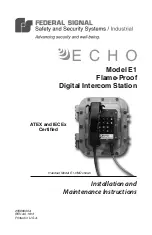
7
5.2. Electrical connections (see FIG. 3)
The electrical connections must be made by a licensed
electrician and comply with applicable local standards.
Complete electrical information about the circulator is given on the
data plate.
- Provide a general switch (two for the double circulator).
- Make sure that the supply voltage is right for the motor and
provide 10-A line protection.
- The connection to the terminal box is via a cable gland, which
may be on either the right or left side.
Use a three or four-conductor cable (two or three earth) to
connect line power to the terminals.
• Three-phase: L1, L2, L3 + Earth.
• Single-phase: L1, L2 + Earth, + external capacitor on L1 and L3.
Terminals 10 and 15 (NC dry contact, 250 V, 1 A) are provided for
remoting of a fault reporting signal to a centralized location.
The power cable must not touch the pipe or the pump; make
sure that it is away from any moisture.
The three-phase circulator is delivered set for 400-V operation. The
voltage must be changed with the pump OFF.
5.3. Choice of voltage and speed (see FIG. 4)
The pump operating speed is coupled to the motor supply voltage.
Set the selector so that the indications of chosen voltage and speed
are against fixed marks U and Vit/Speed.
Any error in the voltage damages the motors. Switch off
before using the speed selector.
• On the double models operating in parallel, the motors must both
turn at the same speed. Make sure that the same indications
(v speed) are against fixed marks U and Vit/Speed.
6. STARTING UP
6.1. Filling, venting
Never operate the circulator WITHOUT WATER.
- Open the valves on both sides of the circulator and fill the
installation completely.
- Vent the circuit at the high point.
- The circulator is drained automatically.
6.2. Adjustments,
Check of direction of rotation
This is done using the diodes inside the terminal box.
The direction indicated by the arrow of the diode should match the
direction marked on the data plate (
see FIG. 5
).
If the motor turns the wrong way, reverse two phase wires on the
motor terminal block.
• Power up the motor to start the circulator.
• The pump flowrate is adjusted by changing the motor speed using
the selector (see § 5.3).
Risk of being burnt. In operation, the motor may
be hotter than 100°C.
7. MAINTENANCE
The circulator needs no special maintenance in operation.
The motor bushings are self-lubricating.
• If the installation is partially or completely drained for a prolonged
shutdown, drain the circulator completely to avoid jamming
problems.
If the motor is removed and reinstalled, take care not to
damage the casing O-ring; if necessary, replace it with a
new O-ring.
Note
: With a double system, make provision for periodic
changeovers (control box Y1200S or PS, or control box with speed
regulation).
ATTENTION !
OPERATING TROUBLES
8.1
THE PUMP FAILS TO START
WHEN POWERED UP
8.2
MOTOR STOPS IN NORMAL
OPERATION
8.3
THE PUMP IS NOISY
CAUSES
a) Fuses blown:
b) Incorrect voltage:
c) The motor is jammed:
a) Fuses blown:
b) The thermal relay has tripped:
c) The motor is jammed by a foreign body
(see 8.1):
d) The thermal overload probe has tripped
out (terminals 10-15):
a) The pump is cavitating because the
suction head is too low:
b) the pump turns the wrong way:
c) Incorrect operating speed:
d) Air in the water circuit:
REMEDIES
a) Check the fuses.
b) Check the mains voltage.
c) If the motor is set to an intermediate or slow speed, set the selector to maximum speed;
If the motor still fails to start when set to maximum speed, disconnect the motor from the
pump casing and unjam the motor by turning the impeller by hand.
a) Check the fuses (rating).
b) Check its setting against the value given on the data plate.
Check the current consumption of each phase.
c) If the motor is set to an intermediate or slow speed, set the selector to maximum speed;
If the motor still fails to start when set to maximum speed, disconnect the motor from the
pump casing and unjam the motor by turning the impeller by hand.
d) Check the water temperature.
Check the power supply.
Note
: The probe resets automatically when the motor has cooled down.
a) Increase the pressure in the network. (see table page 6).
b) Interchange two phase wires on the motor terminal block.
c) Check the operating point and the speed setting, and if necessary correct the latter.
d) Check the venting of the installation..
8 . OPERATING TROUBLES
Switch the circulator OFF before doing any work on it.
ATTENTION !
ENGLISH






























